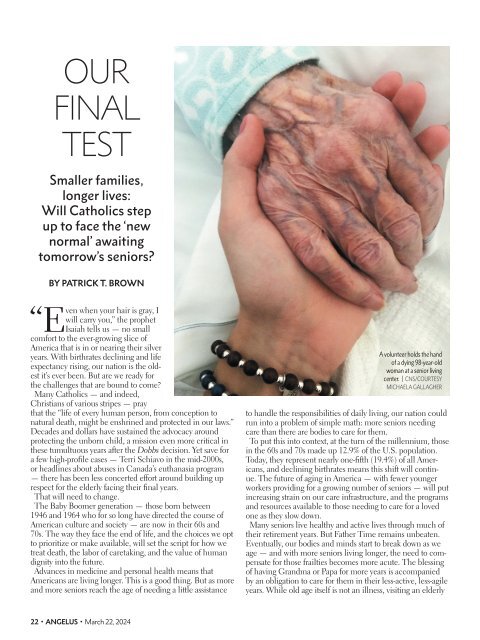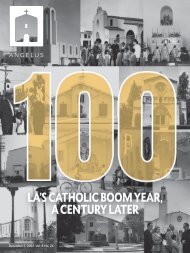Angelus News | March 22, 2024 | Vol. 9 No. 6
On the cover: To cap off a nearly five-decades-long career working in Church communications, Francis X. Maier had an ambitious book idea: a ‘snapshot’ of the Church in America at this time in history that captured both its strengths and its sicknesses. On Page 10, Maier shares what he took away from hearing more than 100 “confessions”’ with American Catholic leaders for the project. On Page 20, John L. Allen Jr. offers his own diagnosis of the uneasy relationship between U.S. Catholics and Rome during the Pope Francis pontificate.
On the cover: To cap off a nearly five-decades-long career working in Church communications, Francis X. Maier had an ambitious book idea: a ‘snapshot’ of the Church in America at this time in history that captured both its strengths and its sicknesses. On Page 10, Maier shares what he took away from hearing more than 100 “confessions”’ with American Catholic leaders for the project. On Page 20, John L. Allen Jr. offers his own diagnosis of the uneasy relationship between U.S. Catholics and Rome during the Pope Francis pontificate.
You also want an ePaper? Increase the reach of your titles
YUMPU automatically turns print PDFs into web optimized ePapers that Google loves.
OUR<br />
FINAL<br />
TEST<br />
Smaller families,<br />
longer lives:<br />
Will Catholics step<br />
up to face the ‘new<br />
normal’ awaiting<br />
tomorrow’s seniors?<br />
BY PATRICK T. BROWN<br />
when your hair is gray, I<br />
will carry you,” the prophet<br />
“Even<br />
Isaiah tells us — no small<br />
comfort to the ever-growing slice of<br />
America that is in or nearing their silver<br />
years. With birthrates declining and life<br />
expectancy rising, our nation is the oldest<br />
it’s ever been. But are we ready for<br />
the challenges that are bound to come?<br />
Many Catholics — and indeed,<br />
Christians of various stripes — pray<br />
that the “life of every human person, from conception to<br />
natural death, might be enshrined and protected in our laws.”<br />
Decades and dollars have sustained the advocacy around<br />
protecting the unborn child, a mission even more critical in<br />
these tumultuous years after the Dobbs decision. Yet save for<br />
a few high-profile cases — Terri Schiavo in the mid-2000s,<br />
or headlines about abuses in Canada’s euthanasia program<br />
— there has been less concerted effort around building up<br />
respect for the elderly facing their final years.<br />
That will need to change.<br />
The Baby Boomer generation — those born between<br />
1946 and 1964 who for so long have directed the course of<br />
American culture and society — are now in their 60s and<br />
70s. The way they face the end of life, and the choices we opt<br />
to prioritize or make available, will set the script for how we<br />
treat death, the labor of caretaking, and the value of human<br />
dignity into the future.<br />
Advances in medicine and personal health means that<br />
Americans are living longer. This is a good thing. But as more<br />
and more seniors reach the age of needing a little assistance<br />
A volunteer holds the hand<br />
of a dying 98-year-old<br />
woman at a senior living<br />
center. | CNS/COURTESY<br />
MICHAELA GALLAGHER<br />
to handle the responsibilities of daily living, our nation could<br />
run into a problem of simple math: more seniors needing<br />
care than there are bodies to care for them.<br />
To put this into context, at the turn of the millennium, those<br />
in the 60s and 70s made up 12.9% of the U.S. population.<br />
Today, they represent nearly one-fifth (19.4%) of all Americans,<br />
and declining birthrates means this shift will continue.<br />
The future of aging in America — with fewer younger<br />
workers providing for a growing number of seniors — will put<br />
increasing strain on our care infrastructure, and the programs<br />
and resources available to those needing to care for a loved<br />
one as they slow down.<br />
Many seniors live healthy and active lives through much of<br />
their retirement years. But Father Time remains unbeaten.<br />
Eventually, our bodies and minds start to break down as we<br />
age — and with more seniors living longer, the need to compensate<br />
for those frailties becomes more acute. The blessing<br />
of having Grandma or Papa for more years is accompanied<br />
by an obligation to care for them in their less-active, less-agile<br />
years. While old age itself is not an illness, visiting an elderly<br />
<strong>22</strong> • ANGELUS • <strong>March</strong> <strong>22</strong>, <strong>2024</strong>

















